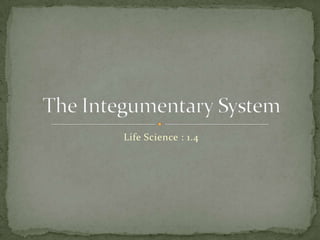Life Science 1.4 : The Integumentary System
•Download as PPTX, PDF•
1 like•2,015 views
Report
Share
Report
Share

More Related Content
Viewers also liked
Viewers also liked (19)
More from Chris Foltz
More from Chris Foltz (20)
Earth Science 3.3 : Absolute Dating: A Measure of Time

Earth Science 3.3 : Absolute Dating: A Measure of Time
Earth Science 3.1 : Earth's Story and Those Who First Listened.

Earth Science 3.1 : Earth's Story and Those Who First Listened.
Life Science 1.4 : The Integumentary System
- 1. Life Science : 1.4 The Integumentary System
- 2. Objectives: List four functions of skin. Describe the two layers of skin. Describe the structure and function of hair and nails. Describe two kinds of damage that can affect skin.
- 3. Functions of Skin Integumentary system Organ system that forms a protective covering on the outside of the body. Made up of your skin, hair, and nails. Skin protects you by Keeping water in your body and foreign particles out of your body. Nerve endings in your skin let you Feel things around you. Skin helps regulate Your body temperature. Skin Also helps Get rid of waste chemicals in sweat. Melanin Determines color of skin
- 4. Layers of Skin Epidermis Outermost layer of skin. Most cells in the epidermis are dead. Thick as only 2 sheets of paper. Keratin Protein that makes skin tough. Dermis Thicker layer of skin that lies beneath the epidermis. Collagen Protein fibers giving skin strength.
- 6. Hair and Nails Hair helps Protect skin from ultraviolet light Regulate body temperature in most mammals. Keep particles out of eyes and nose. A hair forms at the bottom of a tiny sac called a hair follicle. Nails protect The tips of your fingers and toes. A nail grows from living cells in the nail rootat the base of the nail.
- 7. Skin Injuries Skin is often damaged, but fortunately can repair itself. However, damage to the genetic material in skin cells can cause skin cancer.